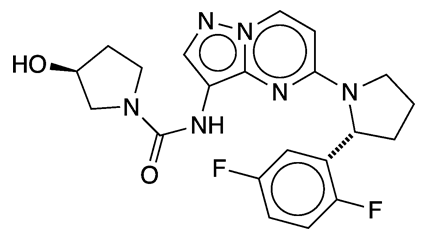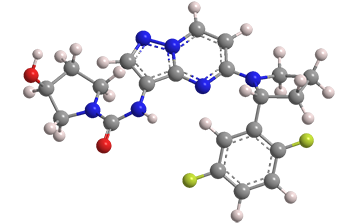What molecule am I?


Larotrectinib (tradename Vitrakvi) is a cancer drug that was discovered by Array BioPharma (Boulder, CO) in the 2000s. In 2013, Array licensed it to Loxo Oncology (Stamford, CT, and South San Francisco, CA). The drug was jointly developed by Loxo (now part of Eli Lilly [Indianapolis]) and Bayer AG (Leverkusen, Germany). In 2018, the US Food and Drug Administration approved larotrectinib for treating cancer patients with a certain genetic marker.
Larotrectinib is the second drug (after Merck’s Keytruda), and the first small molecule, to be approved as a “tissue-agnostic” drug by the FDA. Tissue-agnostic means that the drug is not directed at cancers in specific organs, but rather at cancers caused by particular genetic mutations.
One type of gene mutation produces tumors resulting from the fusion of enzymes in the tropomyosin kinase (TRK) family. Larotrectinib inhibits TRK fusions and shrinks tumors produced by many types of cancer.
As always, there’s a catch. Vitrakvi is outrageously expensive. The Loxo–Bayer partnership has set the monthly wholesale acquisition cost of Vitrakvi pills at US$32,800. The price of the liquid formulation (primarily for children) is somewhat lower at $11,000. The companies justify these prices because of the rarity of patients with TRK fusion mutations.
Larotrectinib hazard information
| GHS classification*: skin irritation, category 2 | |
| H315—Causes skin irritation | |
| GHS classification: skin sensitization, category 1 | |
| H317—May cause an allergic skin reaction | |
| GHS classification: serious eye damage/eye irritation, category 1 | |
| H318—Causes serious eye damage | |
| GHS classification: Respiratory sensitization, category 1 | |
| H334—May cause allergy or asthma symptoms or breathing difficulties if inhaled | |
| GHS classification: specific target organ toxicity, single exposure, respiratory tract irritation, category 3 | |
| H335—May cause respiratory irritation | |
| GHS classification: germ-cell mutagenicity, category 2 | |
| H341—Suspected of causing genetic defects | |
| GHS classification: reproductive toxicity, category 2 | |
| H361—Suspected of damaging fertility or the unborn child | |
| GHS classification: specific target organ toxicity, single exposure, category 1 | |
| H370—Causes damage to organs | |
| GHS classification: hazardous to the aquatic environment, long-term hazard, category 4 | |
| H413—May cause long-lasting harmful effects to aquatic life | |
*Globally Harmonized System of Classification and Labeling of Chemicals. Explanation of pictograms.
Larotrectinib fast facts
| CAS Reg. No. | 1223403-58-4 |
| Empirical formula | C21H22F2N6O2 |
| Molar mass | 428.44 g/mol |
| Appearance | Yellow powder |
| Melting point | Unavailable |
| Water solubility | Insoluble |

Learn more about this molecule from CAS, the most authoritative and comprehensive source for chemical information.
Molecule of the Week needs your suggestions!
If your favorite molecule is not in our archive, please send us a message. The molecule can be notable for its current or historical importance or for any quirky reason. Thank you!
Stay Ahead of the Chemistry Curve
Learn how ACS can help you stay ahead in the world of chemistry.

